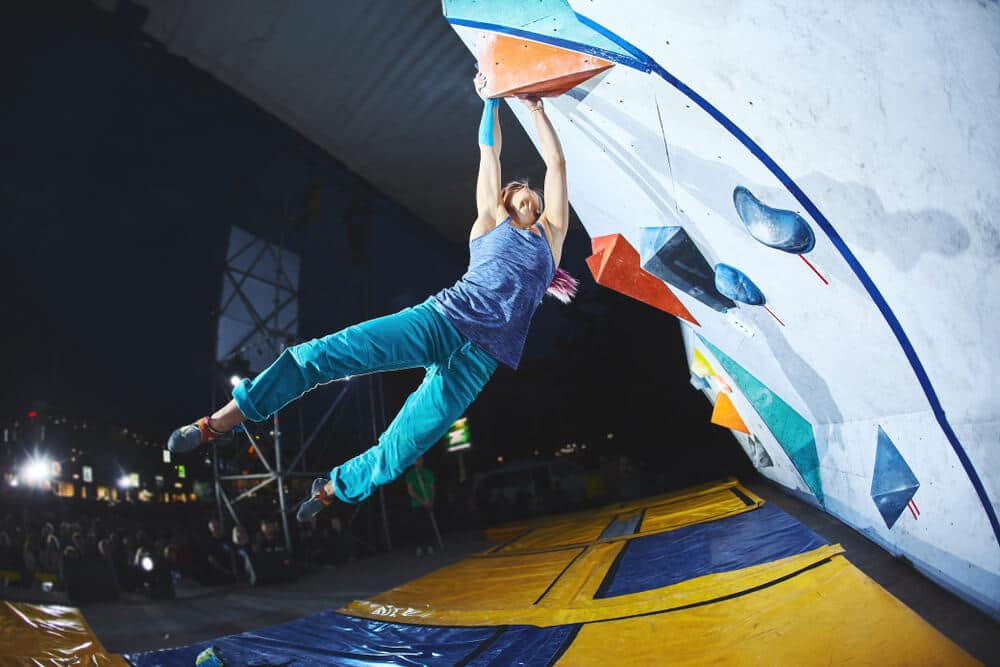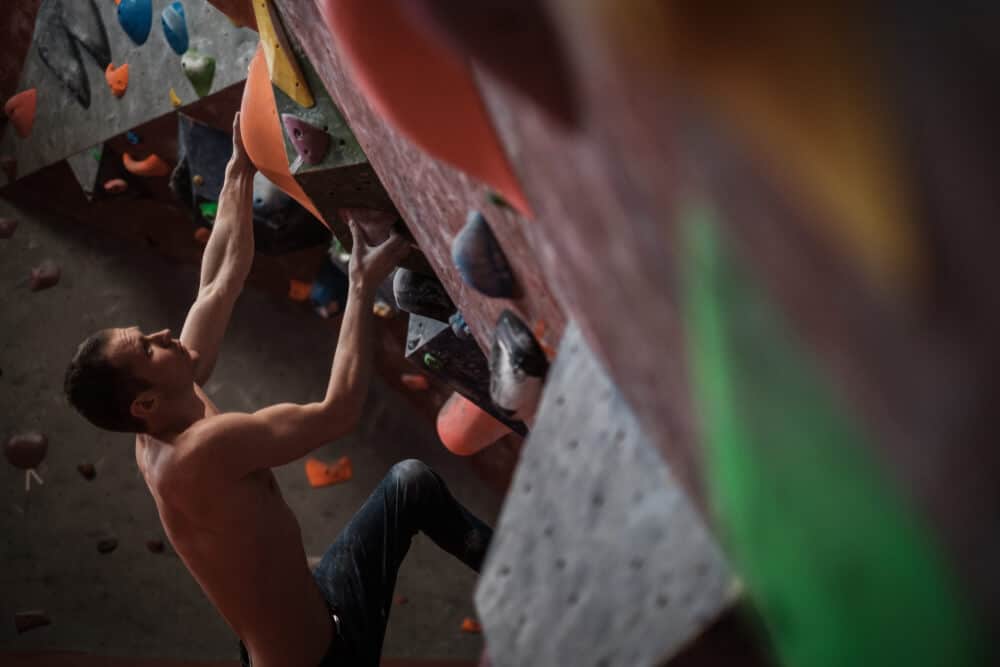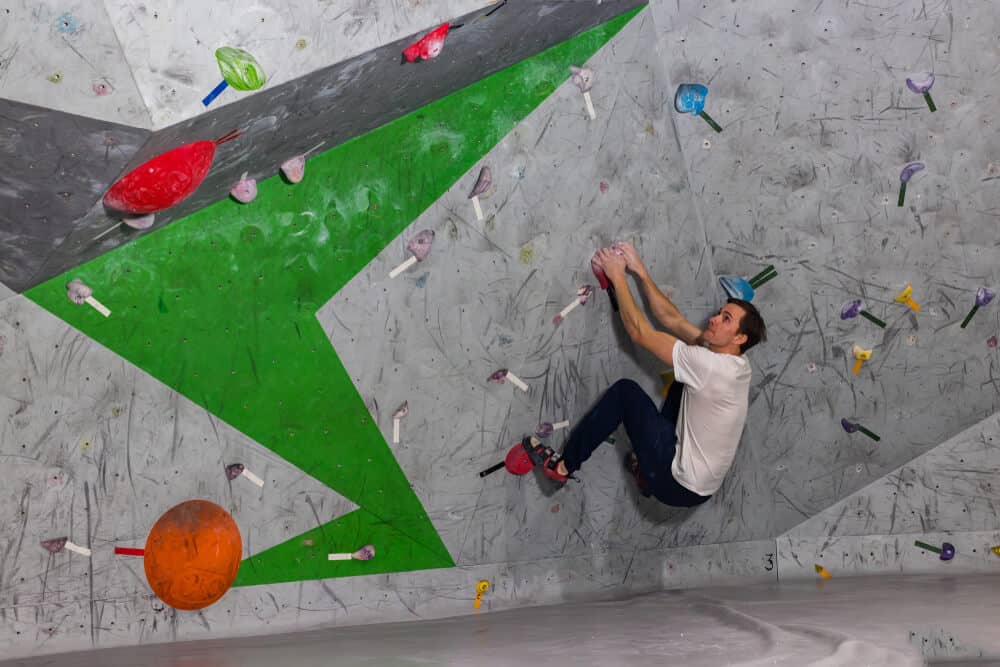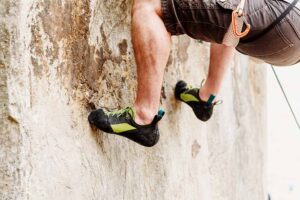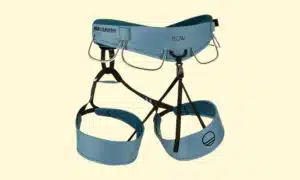If you’ve ever seen people jumping around the climbing gym, throwing themselves at holds way above their heads, you might’ve wondered what in the world they’re doing.
This technique is called a dyno, and it involves a dynamic movement where the climber jumps for the next hold.
Dynos can be nerve-wracking, but they’re something that every climber should learn. Let’s take a look at when to use this type of movement and how to execute it well.
When to Dyno
Many climbers are most comfortable making controlled reaches to to their target hold. While these kinds of static reaches can be energy efficient in certain contexts, sometimes a big or difficult move will be easiest to complete dynamically.
The most obvious situation for a dyno is when you have two good handholds that are very far apart– too far to reach up to your next hold with one hand. Problems like this are often set in the gym, and you’ll see climbers launch themselves upwards, with both hands releasing from the bottom hold at the same time.
In general, anytime you can’t reach your next hold with three points of contact on the wall, you may have to execute a dynamic movement where you have two or less points of contact with the wall (i.e. both hands are midair at the same time).
These types of moves are most common in bouldering, especially indoor competition-style bouldering. However, you’ll also find dynos when outdoor climbing, on boulders and sometimes on sport climbs. It’s rare to dyno when trad climbing, but there are cases of this too.
How to Dyno
There are some key pointers to keep in mind as you master the dynamic style of climbing. Here are a few techniques that will help you execute the coolest moves!
Straight Arms
Dynos are not about locking off. You want to keep your arms straight so you can lever yourself upwards. Doing this will allow you to jump high with less energy; attempting to pull yourself upwards is not the way to do a dynamic move.
High Feet
To dyno successfully requires power. Having your feet high sets you up to push off the wall with the most possible power. If your feet are too low, your leg’s won’t be as bent, translating to less pushing power.
Utilize Your Legs
Climbing is a whole body sport, and dynamic moves are a time when the lower body is key. Climbers who are good at dynos tend to have strong legs. As the climber leaves the start hold, they push off forcefully with their legs in order launch upwards as powerfully as possible.
Start Low
Before you jump upwards, you’ll want to make sure your body is as low as possible. Hang down on your straight arms into a sort of squatting position. The extra momentum created by starting low and launching upwards will help you reach your target hold.
Don’t “Pump”
Many climbers will pump a few times on the start hold: they swing up and down before actually launching themselves. Although this can be tempting, the extra effort required to swing will only serve to tire you out. Limit yourself to one warm-up swing before making the jump.
Familiarize Yourself With The Holds
Understanding what you are jumping too is useful so you can hit the hold in the best possible way. For example, if you’re jumping to small pockets or sharp holds, catching the rock in the right spot can be key.
Engage Your Core
You don’t need incredible core strength to dyno, but in order to maintain tension it is helpful to engage your core muscles. This is especially important in aerial dynos, where all points of contact leave the wall. A tensed core can help you stick the next hold.
Commit to the Move
Properly executed dynamic movement requires commitment. Usually when we climb, we want to grab holds in a very precise manner. However, a dyno is not a controlled reach. To some extent, you need to throw caution into the wind. If you’re used to climbing in a very static way, this can be one of the biggest challenges in learning dynamic moves.
Training for Dynos
While you don’t need to be a superhuman to do a dyno climb, increasing your power can be helpful. If you’ve been climbing for a while, chances are you’re relatively strong in many ways. However, having even greater strength, especially in your fast twitch muscles, will help your dyno ability.
You can do this both on and off the climbing wall. On the wall, it’s as simple as picking climbs with dynamic moves, or purposefully climbing dynamically as opposed to statically. As you begin to incorporate this into your climbing, make sure to be safe. Since you often leave the wall completely, a dyno can lead to a dangerous fall. Be aware of the fall direction. When you climb indoors, there’s likely plenty of padding. If you’re practicing dynos outside, make sure you have a well padded mat.
There are a few situations in climbing where off the wall training can be useful. If you want to master one of the coolest moves out there, you might find it useful to put in a little time in the gym. The focus here should be on increasing your leg power as well as upper body strength.
For your lower body, try doing box jumps. This will increase the strength of those fast twitch leg muscles, and allow you to push off powerfully on the wall. For the upper body, many climbers find it useful to incorporate a simple exercises such as pull-ups into their strength routine. A campus board can also be a useful tool for increasing power, but start slow in order to avoid injury.
Conclusion – Dynos are Fun!
Whether you’re training for a climbing competition or just interested in learning more about one of the coolest moves in climbing, this article should give you a good starting point in terms of learning how to dyno. Dynamic moves can be scary, but even the most spectacular ones are nothing more than a fancy jump. It’s skill that every rock climber can practice and improve upon.


